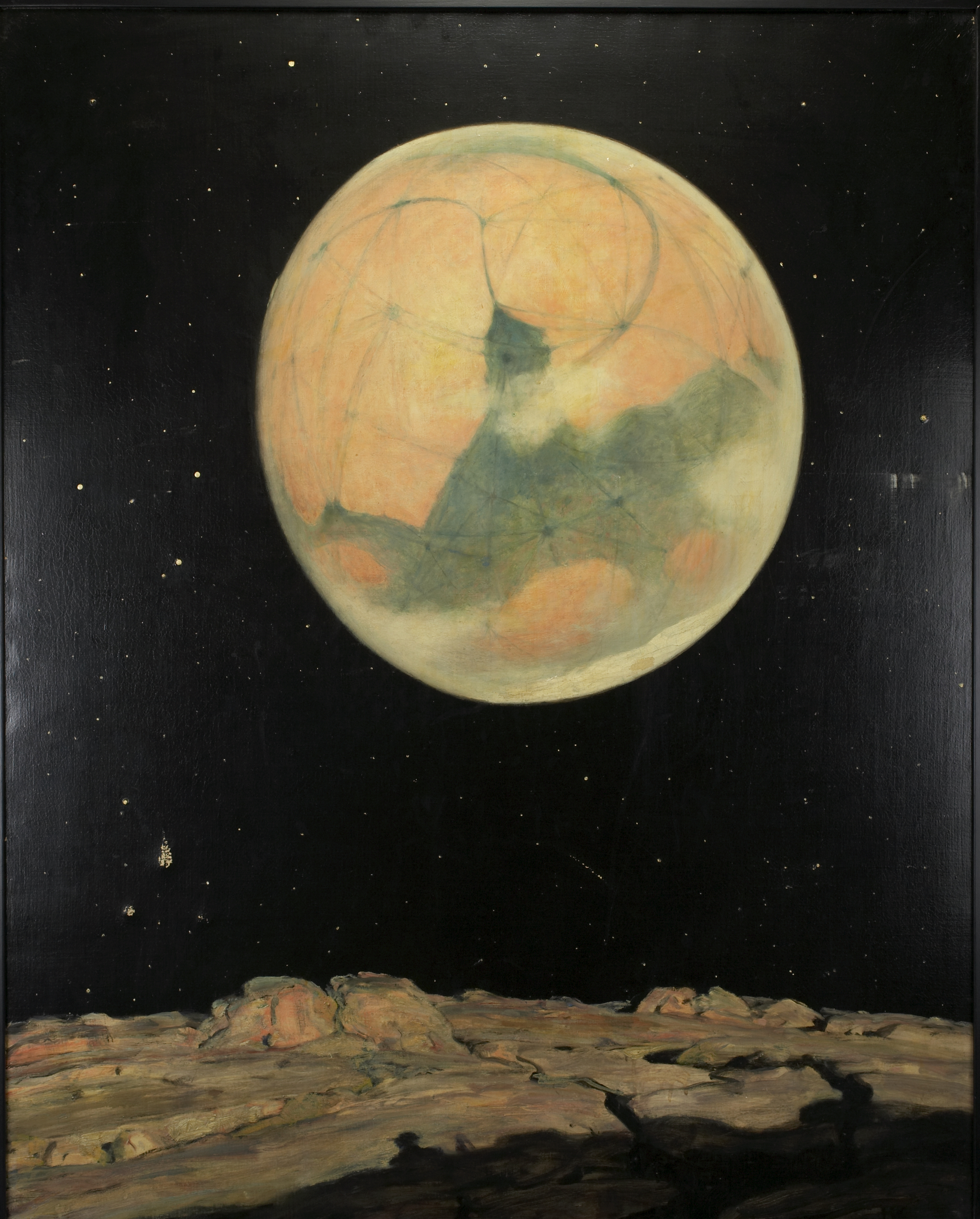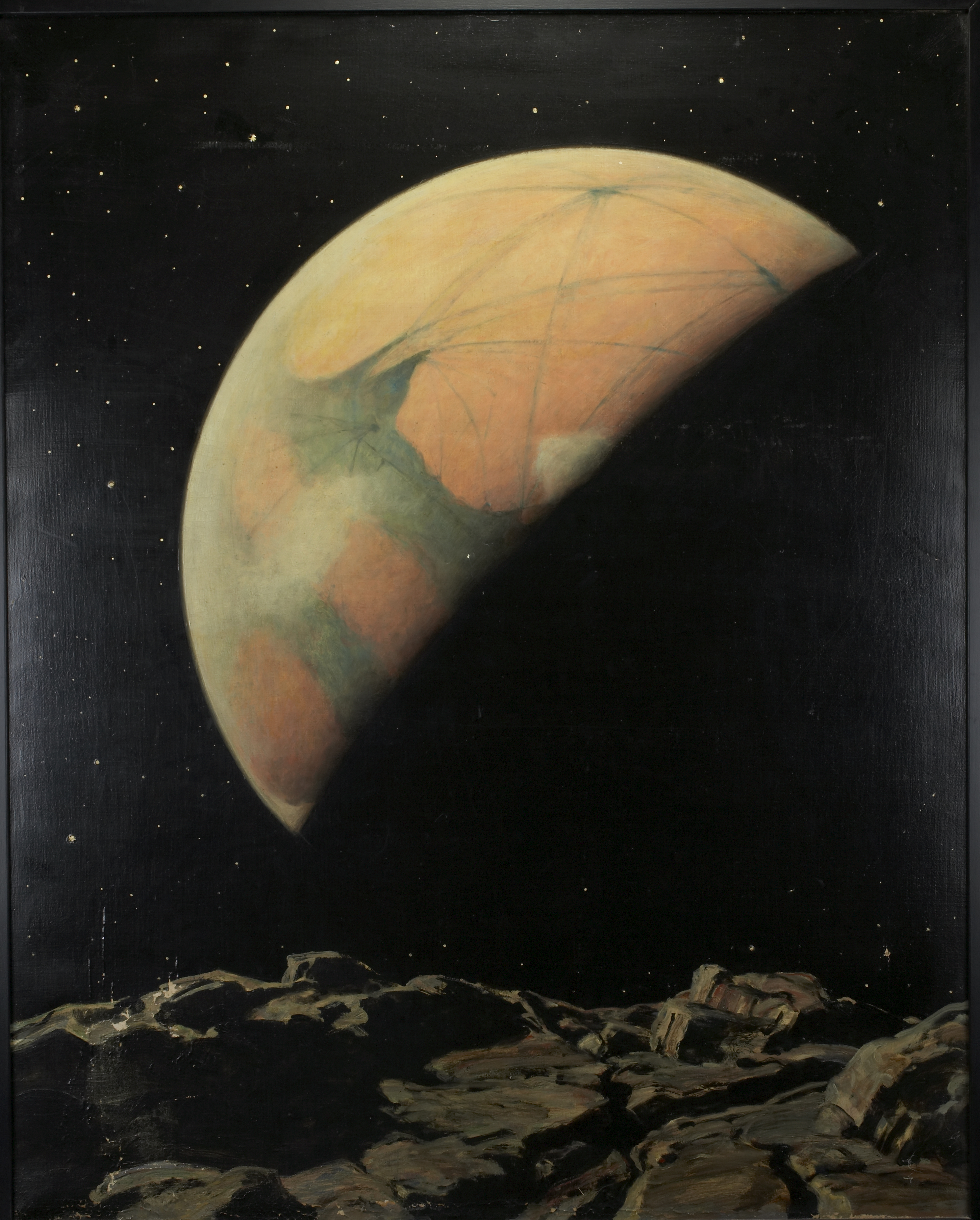Butler’s Moonscapes and Planets
 Butler made some remarkably prophetic paintings that appeared well in advance of human achievement in space exploration. His 1926 moonscape showed what it would be like to stand on the moon’s surface, looking up at the Earth high in the sky. It was not until 1969 when astronauts Neil Armstrong and Buzz Aldrin actually saw such a sight. Butler also made several paintings that speculate on what Earth would look like from the moon, and what Mars would look like if viewed from its two tiny satellites.
Butler made some remarkably prophetic paintings that appeared well in advance of human achievement in space exploration. His 1926 moonscape showed what it would be like to stand on the moon’s surface, looking up at the Earth high in the sky. It was not until 1969 when astronauts Neil Armstrong and Buzz Aldrin actually saw such a sight. Butler also made several paintings that speculate on what Earth would look like from the moon, and what Mars would look like if viewed from its two tiny satellites.
In the 1920s, Butler was an artistic consultant at the American Museum of Natural History. In addition to the large panels illustrating solar prominences that he painted for the Museum, he painted several lunar landscapes with the Earth high in the sky. These moonscapes were the result of a collaboration between Butler and Henry Norris Russell (1877–1957), then professor of astronomy at Princeton. The idea for a “lunar landscape” had occurred to Butler earlier, and at an evening party in Princeton he mentioned it to Russell, who offered on the spot to help him; they proceeded to the Princeton Observatory to study the moon’s surface. The completed picture is a view of the Earth as seen from that crater, incorporating various features of this actual place on the moon. Butler and Russell hypothesized that there was no atmosphere on the moon, and “consequently there would be no diffusion of light.” There would, however, be reflected light. Butler was also aided by photographs of the Earth’s moon made at Mt. Wilson, California, with the world’s largest telescope.
“I supposed your present conception is as good as any for the appearance of the landscape, seen on one of the satellites, Deimos or Phobos. Owing to the very low gravity one might argue either (a) that the surface possessed a very craggy appearance with many spines of rock—as cooling might have taken place, if there ever was cooling, in an irregular manner—; (b) again, one might argue for a nebulous dusty surface, since the gravitational pressures are so small. I would be included on the whole, however, to favor the smooth rolling appearance which you have adopted. Again, the fact is—we do not know and cannot make much of a guess.”
Excerpt from a January 22, 1930, letter from Henry Norris Russell to Butler.
We now know how Mars appears in close-up views from the Mars Global Surveyor (starting in 1999).
Could the artist have placed himself on the surface of Phobos? Take a closer look at the shadow.
Howard Russell Butler, American, 1856–1934
Mars as Seen from Phobos
Oil on canvas
125.5 x 100 cm
Princeton University, gift of H. Russell Butler, Jr.
PP354
Butler depicted Mars according to what was known and could be observed from Earth at that time. He made the paintings of Mars as seen from Deimos and from Phobos accurate to the extent that if the observer is seven feet from either painting, he or she will see Mars in the painting at the same size that Mars would seem if the observer were standing on the Martian satellite and looking at the real Mars in the sky.
Butler consulted with Henry Norris Russell (1877–1957), then professor of astronomy at Princeton University, about what the surface of the satellites of Mars would look like.
Perkin Collection of Astronomy and Astrophysics © American Museum of Natural History Library
To make his martian paintings accurate, Butler used a model of the martian system, as shown in this photo, which was taken in his studio. This model included a globe with surface features indicated according to the best guess of that time, and two small moons mounted on movable arms. (In the photo are also the two martian paintings on the wall, and one of Earth seen from the moon.)
Listen to an audio reading of Butler’s comments regarding his model, published in the October 14, 1930, edition of The Daily Princetonian:
“Of course it could not be done from nature. So the best way I could think of was to rig up my subject in miniature in my studio—a miniature planet, miniature satellites, and an artificial sun. Now to do this involved difficulties. No one knows anything about the surface of the satellites, but the astronomers and other scientists whom I consulted guessed that they were approximately spherical, with rough rocky surfaces, variegated in color, probably rather dark and cracked in every direction. Since such a subject could be modeled in clay I thus made miniatures about 18 inches square of a small section of each of the satellites, and allowed them to dry and crack, after which they were stained. An aluminum globe, a foot in diameter, was given a coat of the reddish-yellow tone characteristic of large areas of Mars, supposed to be deserts. I made the markings of longitude and latitude and the so-called canals. Then using rubber balls at proportionate distances to represent Phobos and Deimos, the two satellites and set to work.
I often wished that I could stand on Deimos and see how the war god really looks. But I fear that the shock would be hard to bear. Besides, I would only weigh an ounce, and survive less than two seconds.”
– Daily Princetonian 55, no. 107 (October 14, 1930)
Howard Russell Butler, American, 1856–1934
Mars as Seen from Deimos
Oil on canvas
Princeton University, gift of H. Russell Butler, Jr.
PP355
“When Howard Russell Butler painted Mars, the prevailing image of its surface was dominated by the sketches of the famous Arizona astronomer Percival Lowell. Lowell is, perhaps, best known for launching the search that led to the discovery of Pluto, although it was not discovered in his lifetime. Lowell firmly believed that there was life on Mars, and he sketched the planet with a level of imagination that exceeded what was visible to him through his telescope eyepiece. He drew networks of interconnecting canals and proposed that they were laid by living and working Martians. Lowell even identified what he thought to be regions of heavy vegetation. Trusting the sketches of one of the most famous astronomers of the day, Butler captured precisely these features on Mars’ surface. Lowell’s observations were, of course, never corroborated. These paintings have thus captured a moment in our scientific past where the need to believe in something overrode the need to be objective.”
Commentary from the retrospective exhibition Art in the Service of Science, Hayden Planetarium, New York, 1996
With permission from Neil deGrasse Tyson, astrophysicist and director, Hayden Planetarium


